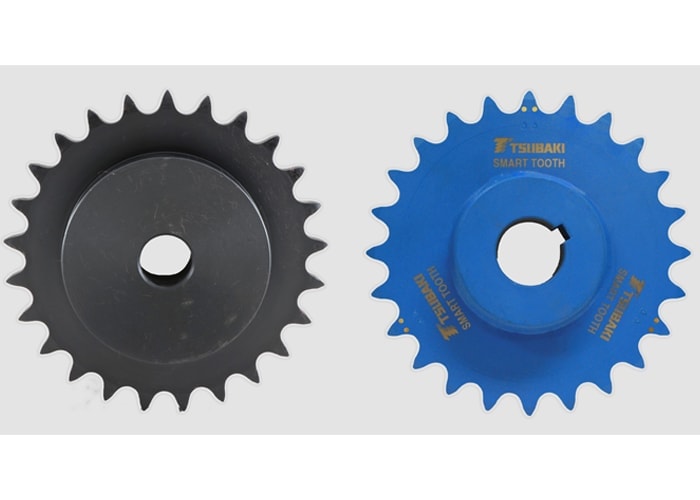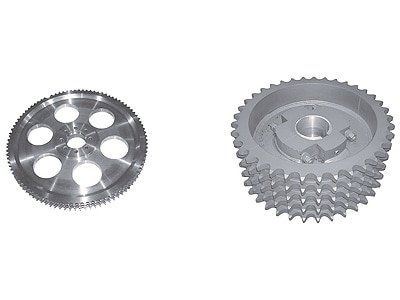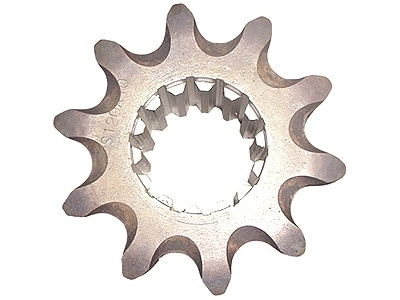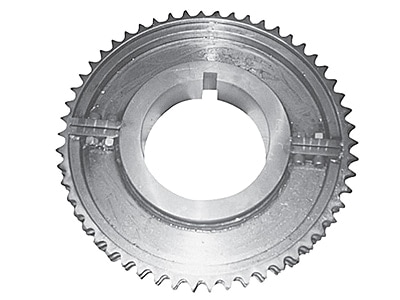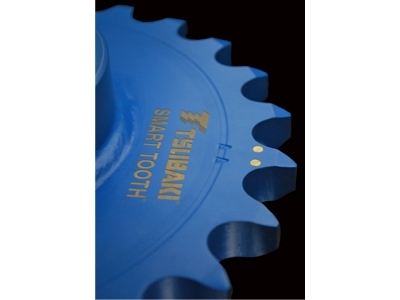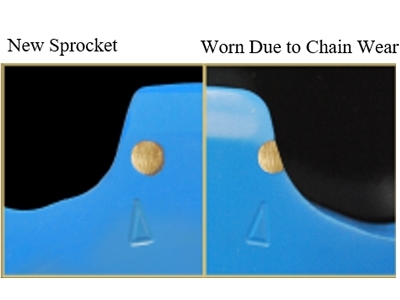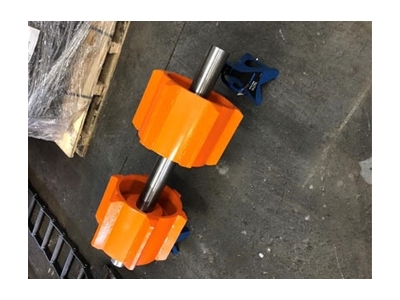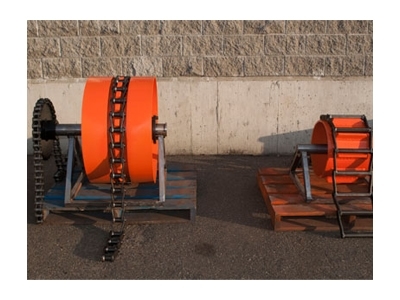Types of Sprockets
Sprockets are sturdy wheels with teeth that lock onto a chain. As the sprocket spins, the teeth grab onto the chain and move other parts that interlock with the chain. This sequential series of operations allows for simple and controlled rotational movement of larger equipment and machinery.
Sprockets are often made from metal or reinforced plastics that can withstand the force of moving the chain. These components are often compared to gears, which share a similar wheel-shaped design with teeth. Unlike gears—which interlock together to transfer rotational movement— sprockets only directly interact with different types of chains. Rather than a gear system, most sprocket and chain systems work in a similar manner to bicycle chain assemblies—which is itself a lightweight sprocket and chain assembly.
Sprockets are highly specialized parts that are fabricated to precisely fit with specific chains and handle specific loads. Sprockets need to meet tight specifications regarding factors such as:
- Size
- Dimensions
- Diameter
- Teeth width and depth
Unless the sprocket is just the right fit for the existing system, it can’t turn the chain correctly and the mechanisms will slip or seize. Incorrectly chosen sprockets can also break down—they will develop wear and teeth will chip or break off. Sprockets that fit their chains, on the other hand, can last a long time without breaking down, even in heavy-duty conveyor system applications.
Important Specifications for Sprockets
 Sprocket assemblies are made of two main components: the sprocket and the chain. If both pieces don’t complement each other, the system will not operate correctly. There are a broad selection of factors to keep in mind when selecting replacement sprockets or designing new sprocket and chain assemblies, such as:
Sprocket assemblies are made of two main components: the sprocket and the chain. If both pieces don’t complement each other, the system will not operate correctly. There are a broad selection of factors to keep in mind when selecting replacement sprockets or designing new sprocket and chain assemblies, such as:
Type
Different types of sprockets have different hubs. A hub is the added thickness around the central plate of a sprocket that doesn’t include the teeth. There are four main types of sprockets as established by the American National Standards Institute (ANSI):
- Type A sprockets, which are only the plate with no added thickness or hubs.
- Type B sprockets, which have a hub on one side.
- Type C sprockets, which have hubs of equal thickness on both sides of the plate.
- Type C offset or Type D sprockets, which also have two hubs. However, each hub has a different thickness, making the sprocket asymmetrical.
The different types allow for different applications. Type A and B sprockets fit snugly against equipment, for example, while Type C sprockets are generally larger and need more thickness to support weight.
Pitch Diameter
For the Chain: Pitch refers to the measurement of a chain from roller-pin center to roller-pin center, which is similar to measuring the distance between interlinking points on a chain.
For the Sprocket: Sprocket diameters are measured three ways:
- Bottom diameter, or the diameter from the lowest points between the teeth on sprockets with even numbers of teeth
- Outside diameter, which measures from the highest point of the sprocket teeth
- Pitch diameter, which falls between the two where the teeth bite into the chain. This measurement dictates if a sprocket is a good fit for the pieces of the matching chain.
Number of Strands
Strands are the rows of teeth along a sprocket’s circumference. Many common sprockets are single strand. Other sprockets may have double or triple sprockets that can grab onto two or three chains at once. Multi-strand chains can drive greater torque and power from a common central shaft.
Caliper Diameter
The caliper diameter is similar to the bottom diameter. It measures the diameter across a sprocket’s plate without including the teeth. When operators are replacing sprockets with worn and broken teeth, the caliper diameter may be the only way to identify the dimensions of the sprocket.
Hub Diameter
The hub diameter measures the diameter of the hub—the additional thickness along the plate around the central bore—on Type B and Type C sprockets.
Length-Through-Bore (LTB)
This is the thickness of the sprocket, and it can be measured from the outside edge of the hub to the outside edge of the opposite hub through the central bore in Type C sprockets. In Type B sprockets, the Length-Through-Bore (LTB) is from the outside edge of the hub to the outside edge on the opposite side of the plate.
The LTB on Type A sprockets is simply the thickness of the plate through the bore. This information determines, or is determined by, the length of the rotating shaft. Larger LTB measurements tend to indicate increased durability.
Tooth Pitch
Sprockets may have wide or narrow teeth, depending on the pitch length in the chains they must match. Chains with a large pitch diameter generally demand sprockets with similarly large teeth, while chains with smaller lengths between roller-pin centers need smaller teeth. Tooth pitch refers to the number of teeth per inch.
Bore Size
The sprocket bore is the hole through the center of the sprocket through which the drive shaft runs. Knowing the diameter of the shaft ensures that the selected sprocket won’t have a sprocket bore that is too small or too large to fit without tilting or slipping.
Number of Teeth
The total number of teeth on a sprocket is an important measurement. The circumference of the sprocket, the number of teeth, and the tooth pitch must all be carefully selected so the sprocket is the right fit for the chain’s pitch and the equipment itself.
Additional Options
Factors beyond size and the number of teeth can be just as important when selecting new sprockets. Metal sprockets can be heat treated and hardened to withstand extreme operating conditions.
Knowing the exact specifications of the chain and the sprocket within a system can ensure that the right replacement parts are designed and fabricated the first time. Using the right parts also keeps the components and the connected equipment safer from shutdowns, overloading, and slippage.
Types of Sprockets & Applications
There are many different types of sprocket and chain assemblies. Each type drives different types of machinery that run on movement in different applications and industries. For example, sprocket assemblies can be found in the following applications:
- Agricultural and farming equipment
- Automotive equipment
- Chain-driven machinery, such as conveyor belts and other factory systems
- Pulleys, shafts, and other power transmission equipment
- Vehicles, such as bicycles and motorcycles
There are many different sprocket types, including:
Roller Chain
Roller chain sprockets are the most common type of sprocket. They operate along chains formed by rollers interlinked by pins. These chains form the gaps that the sprocket’s teeth fit into in order to transfer movement energy. These are most frequently used in transmission equipment.
Single-Pitch and Double-Pitch
Single-pitch sprockets have spaced teeth that allow the chain’s roller pins to fall into every tooth. Double-pitch sprockets have teeth that are spaced so the pins fall into every other gap. These are used in conveyor systems that require precise product placement.
Smart Tooth® Sprockets
Tsubaki’s patented wear indicator sprockets (Smart Tooth®), have wear indicator pins on one or more sprocket teeth that provide visual indication that the sprocket is still within the allowable wear tolerance or that it needs to be replaced. This type of sprocket saves the chain from breaking as it provides the ability to identify and schedule drive system maintenance before critical component failure occurs.
Drum
Drum sprockets are thick sprockets that focus on lowering contact pressure through increased surface area. The teeth, plate, and hub(s) are much wider to reduce wear. These sprockets are commonly used for heavy-duty and industrial applications.
Steel-Split
Many sprockets have to be installed through slackening the chain, placing the sprocket, and retightening the chain. However, steel-split sprockets have two separate parts that are split through the center and bolted back together, facilitating easier installation into an existing system.
Idler
If a system has a long chain, it might become slack around non-adjustable shafts or in long routes of chain around obstructions. These idler sprockets can prevent uneven load distribution along the chain and stop any potential chain whipping.
Bushed
These systems have additional supports, such as anchor bolts, to ensure that the flange sticks to the sprocket. Industry systems that convey heavy loads often require bushed sprockets.
About U.S. Tsubaki
U.S. Tsubaki Power Transmission, LLC is a leading manufacturer and supplier of motion control and power transmission products and is a subsidiary of the Tsubakimoto Chain Company, headquartered in Japan. With over 100 years of manufacturing experience, Tsubaki prides itself on excellence in quality, reliability, and customer service and strives to be the manufacturer who provides the best overall value to customers.
U.S. Tsubaki specializes in designing and manufacturing high-quality sprockets. Our services include:
- Fabricating sprockets that are compliant with ISO 9001 standards
- Optional finish applications, such as heat treatments and hardening
- Installation of sprocket and chain assemblies
- Troubleshooting and reparative installation services to avoid problems such as misalignment, excessive wear and noise, and more.
U.S. Tsubaki also creates and installs heavy-duty drum sprockets and other sprocket assemblies.
Additional Sources
To learn more about sprockets, the right configurations for your facility, and how to keep sprocket systems in optimal conditions, read more of our resources, including:
- Our Tsubaki Blog, which has helpful guides for protecting, designing, and implementing sprocket systems
- Our library of Technical Resources includes plant videos, how-to videos and other useful tools
- Our library of Literature includes brochures, catalogs and flyers.
Sprockets can help power chain-driven movement systems that carry heavy loads. Choosing the right sprocket makes systems work smoothly without damaging or wearing the equipment. In order to choose or design the right sprockets, it’s important to know the specifications of the sprockets and chains in the system, as well as information about the assembly type.
Contact us today with the details of your project to receive a free quote.


